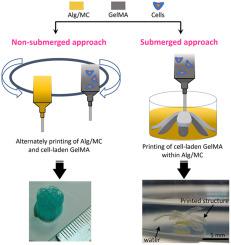Additive Manufacturing ( IF 10.3 ) Pub Date : 2020-10-01 , DOI: 10.1016/j.addma.2020.101640 Huijun Li , Yu Jun Tan , Raj Kiran , Shu Beng Tor , Kun Zhou

|
Extrusion-based bioprinting suffers from the poor printability of such hydrogels as gelatin methacrylate (GelMA) due to their low viscosity and difficulty in printing them into structures of complex shape. The present study deals with hydrogel materials by focusing on the mixture of cell-laden photopolymerizable GelMA as a main printing material and the mixture of alginate and methylcellulose (Alg/MC) as a support material because of its high viscosity and good thixotropic property. One extrusion-based approach is developed by printing the two mixtures into structures in an alternating layer-by-layer manner, with the electrostatic interactions between polycationic GelMA and polyanionic Alg/MC contributing to the integrity of the structures. The final printed structures are exposed to ultraviolet (UV) light to form crosslinks in GelMA through photopolymerization for further structural strengthening. The one-time UV exposure minimizes cell damage in cell-GelMA, demonstrating an advantage over previously reported studies that required repeated UV exposures upon the printing of each layer of a structure. The other approach is developed by submerging the extrusion nozzle into a bath of Alg/MC to print cell-laden GelMA structures, which, upon printing completion, are also subject to one-time UV exposure before the removal of the support material Alg/MC. A flower with living cells is printed using this approach to demonstrate its capability of fabricating structures with geometric complexity. The structures printed using both approaches demonstrate a well-maintained shape fidelity, structural integrity and cell viability of over 93% up to five culturing days. The proposed two printing approaches based on the cell-GelMA and Alg/MC pair will be beneficial for exploring new opportunities in bioprinting.
中文翻译:

使用水凝胶对GelMA和藻酸盐/甲基纤维素制造复杂结构的淹没式和非淹没式3D生物打印方法
基于挤出的生物印刷由于其低粘度和难以将它们印刷成复杂形状的结构而遭受诸如甲基丙烯酸明胶(GelMA)之类的水凝胶的差的可印刷性。本研究针对水凝胶材料,因为它具有高粘度和良好的触变性,因此着重研究了充满细胞的可光聚合GelMA作为主要印刷材料的混合物以及藻酸盐和甲基纤维素(Alg / MC)的混合物作为载体材料的情况。通过将两种混合物以逐层交替的方式印刷到结构中,从而开发出一种基于挤出的方法,其中聚阳离子GelMA和聚阴离子Alg / MC之间的静电相互作用有助于结构的完整性。将最终印刷的结构暴露于紫外线(UV)下,通过光聚合作用在GelMA中形成交联,从而进一步增强结构。一次性UV暴露使cell-GelMA中的细胞损伤最小化,这证明了其优于先前报道的研究的优势,该研究要求在印刷结构的每一层时都要反复进行UV暴露。另一种方法是通过将挤出喷嘴浸入Alg / MC浴中以印刷载有单元的GelMA结构来开发的,该结构在印刷完成后也要经受一次UV暴露,然后再去除支撑材料Alg / MC 。使用这种方法可以打印出带有活细胞的花朵,以展示其制造具有几何复杂性的结构的能力。使用这两种方法印刷的结构都表现出良好的形状保真度,长达五个培养天的结构完整性和细胞活力超过93%。根据细胞-GelMA和Alg / MC对提出的两种印刷方法将有助于探索生物印刷的新机会。










































 京公网安备 11010802027423号
京公网安备 11010802027423号